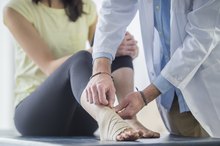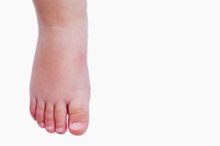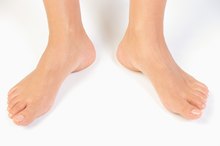Fluid Buildup in the Calf
Swelling is part of your body’s natural response to inflammation from a traumatic injury, or it can signal that your body is having difficulty circulating fluids. Swelling that's concentrated in your calf or calves can simply result from standing in place for too long, or it can signal a more serious condition, such as a blood clot in your leg. Always seek emergency medical treatment if fluid starts to build in your leg and you have no explanation for why your calf became swollen.
Less Traumatic Causes
Some causes of fluid buildup in your calf do not signal a medical emergency. This is true when you experience the fluid buildup after you have been on your feet or sitting for some time. The condition develops because gravity attracts fluid in your legs, pulling it away from other areas of your body and toward your calf. If you are overweight, you are more likely to experience this type of swelling because your body may have difficulty circulating blood and other fluids. Also, if you have experienced an injury, such as a blow to the leg or bruising, your body’s inflammatory response may cause you to experience swelling in your calf. If your swelling does not improve with a change of positioning or with time, this could signal a more significant injury.
- Some causes of fluid buildup in your calf do not signal a medical emergency.
- If your swelling does not improve with a change of positioning or with time, this could signal a more significant injury.
Peripheral Edema
How to Tell If Your Legs Are Swollen With Fluid
Learn More
Peripheral edema is a medical condition that occurs when the portions of your body responsible for fluid filtration are not filtering effectively. These areas include your kidneys, circulatory system or lymphatic system. The result can be swelling in your calf or legs that can indicate medical conditions such as kidney failure, a blockage of your lymphatic system or swelling around the heart. While these are not necessarily emergency conditions, they do indicate the need for further examination.
- Peripheral edema is a medical condition that occurs when the portions of your body responsible for fluid filtration are not filtering effectively.
- The result can be swelling in your calf or legs that can indicate medical conditions such as kidney failure, a blockage of your lymphatic system or swelling around the heart.
Medications
Taking certain medications can contribute to fluid buildup in your calves. Medications such as antidepressants, blood pressure pills, estrogen hormones and steroids are all associated with causing swelling in your body, including your legs. Talk to your doctor or pharmacist to determine if medications you are taking could potentially contribute to leg swelling. You can take some preventive measures to keep this from occurring, such as a low-sodium diet, elevating your legs when sitting or lying down or wearing support circulation stockings, according to MedlinePlus.
- Taking certain medications can contribute to fluid buildup in your calves.
- Talk to your doctor or pharmacist to determine if medications you are taking could potentially contribute to leg swelling.
Warning
How to Relieve Ankle Swelling Naturally
Learn More
Some accompanying symptoms to your fluid buildup can indicate the need for emergency medical attention. If you have leg swelling accompanied with breathing difficulties, fainting, confusion and chest pain, this could indicate you are experiencing a blood clot in your leg. Because the clot can break off and cause a deadly pulmonary embolism, it’s important to seek medical attention immediately.
Related Articles
References
- GeriCare Online: Leg Swelling and Fluid Retention
- MedlinePlus: Foot, Leg and Ankle Swelling
- MayoClinic.com: Leg Swelling
- Rainbow CR, Fields KB. Calf injuries not involving the Achilles tendon. Fricker P, ed. UpToDate. Updated Feb 7, 2019.
- Chikazawa K, Netsu S, Akashi K, Suzuki Y, Konno R, Motomatsu S. Delayed diagnosis of single compartment muscle contusion after radical hysterectomy in the lithotomy position: A case report. Int J Surg Case Rep. 2016;26:199-201. doi:10.1016/j.ijscr.2016.07.057
- Fields KB, Rigby MD. Muscular Calf Injuries in Runners. Curr Sports Med Rep. 2016;15(5):320-4. doi:10.1249/JSR.0000000000000292
- Freedman BR, Gordon JA, Soslowsky LJ. The Achilles tendon: fundamental properties and mechanisms governing healing. Muscles Ligaments Tendons J. 2014;4(2):245-55.
- Alessandrino F, Balconi G. Complications of muscle injuries. J Ultrasound. 2013;16(4):215-22. doi:10.1007/s40477-013-0010-4
- Picerno V, Filippou G, Bertoldi I, et al. Prevalence of Baker's cyst in patients with knee pain: an ultrasonographic study. Reumatismo. 2014;65(6):264-70. doi:10.4081/reumatismo.2013.715
- Baima J, Krivickas L. Evaluation and treatment of peroneal neuropathy. Curr Rev Musculoskelet Med. 2008;1(2):147-53. doi:10.1007/s12178-008-9023-6
- Petsche TS, Selesnick FH. Popliteus tendinitis: tips for diagnosis and management. Phys Sportsmed. 2002;30(8):27-31.doi:10.3810/psm.2002.08.401
- Stager A, Clement D. Popliteal artery entrapment syndrome. Sports Med. 1999;28(1):61-70. doi:+10.2165/00007256-199928010-00006
- Mcdermott MM. Lower extremity manifestations of peripheral artery disease: the pathophysiologic and functional implications of leg ischemia. Circ Res. 2015;116(9):1540-50. doi:10.1161/CIRCRESAHA.114.303517
- Crum-cianflone NF. Bacterial, fungal, parasitic, and viral myositis. Clin Microbiol Rev. 2008;21(3):473-94. doi:10.1128/CMR.00001-08
- Somford MP, Hoornenborg D, Wiegerinck JI, Nieuwe weme RA. Are You Positive That the Simmonds-Thompson Test Is Negative? A Historical and Biographical Review. J Foot Ankle Surg. 2016;55(3):682-3. doi:10.1053/j.jfas.2016.01.021
- Pulivarthi S, Gurram MK. Effectiveness of d-dimer as a screening test for venous thromboembolism: an update. N Am J Med Sci. 2014;6(10):491-9. doi:10.4103/1947-2714.143278
- Bryan dixon J. Gastrocnemius vs. soleus strain: how to differentiate and deal with calf muscle injuries. Curr Rev Musculoskelet Med. 2009;2(2):74-7. doi:10.1007/s12178-009-9045-8
- Mackman N. Triggers, targets and treatments for thrombosis. Nature. 2008;451(7181):914-8. doi:10.1038/nature06797
- Muir RL. Peripheral arterial disease: Pathophysiology, risk factors, diagnosis, treatment, and prevention. J Vasc Nurs. 2009;27(2):26-30. doi:10.1016/j.jvn.2009.03.001
- American Academy of Orthopedic Surgeons. Muscle Contusion (Bruise). Updated 2014.
- American Physical Therapy Association. Physical Therapist's Guide to Calf Strain. Updated Oct. 17, 2019.
- Childress MA, Beutler A. Management of Chronic Tendon Injuries. Am Fam Physician. 2013 Apr 1;87(7):486-90.
- Grabowski G, Whiteside WK, Kanwisher M. Venous Thrombosis in Athletes. J Am Acad Orthop Surg. 2013 Feb;21(2):108-17.
- Rainbow CR, Fields KB. Calf injuries not involving the Achilles tendon. Fricker P, ed. Updated Feb 7, 2019.
Writer Bio
Rachel Nall began writing in 2003. She is a former managing editor for custom health publications, including physician journals. She has written for The Associated Press and "Jezebel," "Charleston," "Chatter" and "Reach" magazines. Nall is currently pursuing her Bachelor of Science in Nursing at the University of Tennessee.







